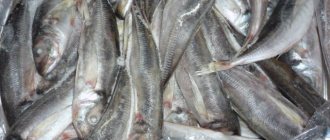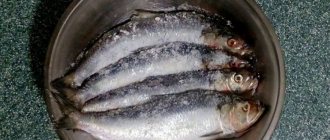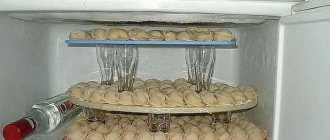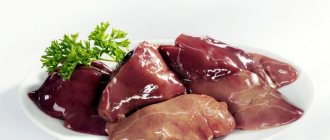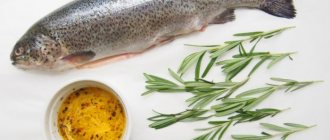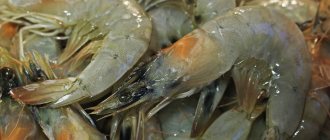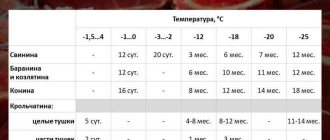Without knowing how long fried fish can be stored in the refrigerator, it is easy to get food poisoning. This is due to the fact that in the early stages of decomposition the product looks and smells like fresh, but the amount of toxins in it is no longer safe for the human body. The general rules are as follows: cooked fish can be stored in the main compartment of the refrigerator for up to 3 days, in the freezer for up to 3 months.
How to store fried fish in the refrigerator?
Depending on the desired shelf life, fried fish is placed either in the refrigerator or in the freezer.
The selected device must provide the following temperature regime:
- from +2 to +6°C – the freshness of the product is maintained for 36 hours;
- from -18 to -24°C – within seven days the loss of taste will be minimal, and the fish will remain suitable for consumption for up to three months.
It is important to take into account the fact that the temperature in household refrigerators is not always stable. Their chambers are designed in such a way that there should be free space between the shelves and the products located on them for the circulation of cold air. However, housewives often stack plates, pots, bags and trays almost side by side - this leads to an increase in temperature by 3-5 degrees, as a result of which food spoils much faster.
Storage conditions for fresh fish
Raw fish is a highly perishable product. Uncleaned carcasses can be stored in the refrigerator for 2 hours. Next, the process of rotting and the proliferation of harmful microorganisms begins. Before cooking, seafood can be left on the table for 30-60 minutes. By observing a number of mandatory rules, it is possible to extend the shelf life:
- remove scales;
- get the gills;
- cut off the head;
- rinse thoroughly with running water.
The main requirement is the absence of moisture. Wipe the fish thoroughly with a dry cloth, then dry completely.
It is advisable to place the prepared raw workpiece in a plastic container with a lid. Glassware may be used. Usage time: 1 day in the refrigerator. If you need to preserve the carcass for more than a day, sprinkle salt on top and sprinkle with lemon juice. Store the salted ingredient for 24-48 hours.
Fish purchased in vacuum packaging is good for 4-5 days. Do not place milk or bread nearby. Because they quickly absorb the smell.
Other raw fish products are suitable for consumption within:
- minced cutlet – 10 hours;
- carcass in pieces – 9-10 hours;
- fillet – 2 days.
Even in the refrigerator, the workpiece quickly becomes sticky and viscous, so it is better to cook it right away or freeze it. When purchasing a store-bought product, follow the manufacturer's recommendations on the label.
To identify freshly caught fish, several factors should be taken into account:
- smell – faint sea (river), iodine aroma;
- scales – elastic;
- eyes – open, bulging;
- gills are light in color. Dark colors characterize damaged goods;
- is in a container with ice.
If the fish was bought in reserve, it will take 2 days to cook, it is better to freeze it. This method has a number of advantages:
- The carcass does not need to be cleaned. Some varieties are not specially peeled; the scales add additional taste;
- remains useful for 2 months, fatty varieties – 6-12;
- It is impossible to be poisoned by a long-lasting frozen ingredient.
Cooling
Before placing the fish in the refrigerator, it is removed from the stove and kept until it reaches room temperature. Then they are transferred to plastic or enamel containers with lids and placed on the bottom shelf. If special containers are not available, you can use a plate well wrapped in cling film or tightly folded aluminum foil.
You cannot store fish in a cast iron frying pan, even if it has been fried there. This metal reacts with foods and accelerates the oxidation of omega-3s.
Storing minced fish
After preparing minced meat and purchasing it in a supermarket, it can be stored for 6 hours by placing it in the refrigerator. Next you need to use it for cooking. If there is any minced meat for future use, it must be frozen. Store at a temperature of -6-18°C – 3 months. It is permissible to leave purchased packaged minced meat in a cold place for a day.
An important requirement is not to damage the integrity of the packaging.
Fish is good for humans, has a positive effect on the heart, immune system, blood vessels, and serves as a prevention of cancer. It contains omega 3 acid, proteins, vitamins, phosphorus, and calcium. To maintain the balance of nutrients in the body, you need to consume only proven quality foods. It is necessary to check the date of manufacture on fish products if they were purchased in a store or put a mark on home-made products. After the expiration date, be sure to dispose of the seafood product.
I like it I don't like it
Freezing
At catering establishments, food is frozen using the shock method, which cannot be done at home. For this reason, fried fish should first be cooled to room temperature, then placed in a regular refrigerator for an hour or two, and only then put in the freezer. This method will ensure uniform freezing of each piece and better preservation of taste.
We recommend: How to store wires and chargers conveniently and out of sight?
It is advisable to freeze fish by placing it in special bags in one layer. After it has completely frozen, in order to save space, it can be folded into a container more tightly.
Do not leave the product in the freezer in an open container or untied bag, as this leads to “frost burn” - a rapid loss of moisture, as a result of which the fish becomes tasteless and unattractive in appearance.
Shelf life
Cold smoked fish can be stored the longest at home. It will keep quietly in the refrigerator for 10 days. Mackerel, horse mackerel and other hot smoked fish will need to be eaten within three days. The optimal location is the middle shelves near the back wall, where the temperature is kept at +3°.
Make sure there is no mold. To prevent this, you need to choose clean packaging and ensure a flow of fresh air. This means that the refrigerator must be clean, defrosted in a timely manner, and spoiled food must not be stored in it.
You will know that the fish has gone bad if it:
- became slippery to the touch;
- covered with a dirty gray or greenish coating;
- emits a sour, unappetizing odor.
Decomposition begins in the spine area. You can stick a toothpick in and check the smell. If a whitish coating appears, but there is no smell yet, then wipe the fish with vegetable oil or salt using a clean cloth.
Packing fish before storage
For long-term storage of fried fish, not only the temperature in the refrigerator is important, but also the packaging, since it performs several functions at once:
- Localization of odor. If you put the dish on a plate and put it on the shelf in this form, the rest of the food will be saturated with a specific fishy aroma. Butter, cheese, fruits and eggs are especially susceptible to this effect.
- Protection against microorganisms. No matter how clean the refrigerator may seem, colonies of pathogenic bacteria and mold fungi still live in it. And fatty protein foods are an ideal substrate for their reproduction, so fish stored in open containers becomes hazardous to health much faster.
- Moisture retention. The longer food sits in the refrigerator, the more liquid it evaporates. Consequently, the attractive appearance and taste are lost.
- Preventing foreign objects from entering the product. Insects from poorly washed greens or pieces of other food (for example, cake crumbs) can get into the dishes where the fish is, causing it to become infected or spoil prematurely.
The ideal container for fried fish is vacuum bags, in which it does not dry out even after a long period of storage in the freezer. In addition, in an airless space, the fat oxidation reaction occurs very slowly, so the product does not taste bitter.
We recommend: How to store dried apricots at home: 3 ways
An alternative to such bags can be sealed containers. For freezing, you should choose those that can withstand sub-zero temperatures. But foil, cling film and ordinary plastic bags can only be used for short-term storage in the main chamber of the refrigerator.
How to store fresh and frozen fish?
Fresh fish is the most valuable for consumption, since dishes made from it will turn out to be the most delicious and healthy, compared to smoked and canned fish, for example.
But if you couldn’t prepare this product right away, you can store it in the refrigerator or freezer.
How to store fish in the refrigerator?
You can store fresh fish in the refrigerator for about two days, but this is provided that it is cleaned and gutted.
- It is advisable to store fresh fish in: the Bio-fresh section (available in Liebherr refrigerators), where optimal conditions are created for storing such products;
- in special drawers;
- just on the middle shelf, where the temperature is optimal.
- After cleaning, wash the carcass and pat dry with a paper napkin, inside and out.
- The product will be better preserved in a bowl covered with a lid or cling film.
- If you want to enhance the preservation of fresh fish, then salt it or sprinkle it with lemon juice. These substances act as natural preservatives. Before preparing the dish, you can simply wash off the salt with water, and lemon juice, like a marinade, will only add tenderness to the fillet.
Another way to prolong the shelf life of fish is to immerse it in a tray of ice. For this:
- Take a deep container and add crushed ice to the bottom.
- Then place the fish and also add ice on top.
- It is advisable to place drainage at the bottom of the vessel so that when the ice melts, the fish does not float in the water.
- Periodically drain the liquid and add ice.
- It is better to store fillets in a glass container. Coat it with a layer of sunflower oil or cover with damp paper towels.
How to store fish in the freezer?
If you are not sure that you will start cooking fresh fish in a couple of days, then put it immediately in the freezer. Here it can be stored for months, up to a year.
To avoid the unpleasant situation of spoiled or forgotten food in the freezer, take note of the following recommendations:
- In order not to lose sight of the shelf life, put a sticker with the date the product was stored.
- It is advisable to freeze uncleaned fish. This way it will better retain its taste.
- If there are several fish, and then you will take them out one at a time, then freeze them in separate bags.
- If you don’t want the carcass to lose its shape and curl up between other products, then freeze it first on a tray and then put it in a bag.
- When it's time to take out the fish, don't rush through defrosting. If you rush this process with the help of hot water, a battery, a microwave and other tricks, you will get an unappetizing, shapeless and tasteless dish. It is better to take the fish out of the freezer in advance and put it in the refrigerator. It will melt within a day and you can cook something from it.
Warm up before use
Fish that has been stored in the refrigerator for less than 12 hours at a temperature of +2 to +6°C can be eaten cold if desired. If it spent longer there, it should be warmed up before use - fry it in oil for at least two minutes or boil it in sauce. The second method is preferable because the taste of the product is better preserved.
Frozen fried fish must be defrosted in the main compartment of the refrigerator and only then reheated. The product should not be re-frozen as this will significantly shorten the shelf life and impair the taste.
It is not recommended to use a microwave for heating: the fish will acquire a “rubbery” consistency.
It is better to keep fish in the refrigerator raw (chilled or frozen), using it for cooking as needed. But if it happens that you fried more pieces than you can eat at once, there is nothing wrong with leaving them for later, observing all storage rules and temperature conditions.
Shelf life and storage conditions of fish according to sanitary standards
SanPiN 42-123-4117-86 contains information on the rules for storing particularly perishable products, which include fish.
The maximum period for its storage in raw form does not exceed 72 hours. A temperature regime of no higher than +6 degrees must be ensured. Higher temperatures provoke the active proliferation of bacteria that cause serious food poisoning.
Isothermal transport is used to transport products. If transportation is carried out in the summer, then it is necessary to ensure that the products are kept in ice. In such conditions, transportation within 3 hours is allowed. If there is no ice, delivery to the destination is carried out within one hour.
The raw storage temperature is within +2…+6 degrees.
In rare cases, the storage period of a large batch that has arrived at the store is extended for a period of no more than 50% of the established storage period.
Production of natural fish culinary products
Fried fish is one of the main types of culinary products produced by fish gastronomy factories. Sometimes it is produced with the addition of various sauces, marinades and side dishes.
For the production of fried fish, chilled and frozen fish of various families (except sturgeon and salmon) are widely used, but more often these products are made from sea and ocean fish, such as navaga, capelin, horse mackerel, mackerel, flounder, silver hake, cod, sabre- fish, sprat, ice sprat, grenadier, epigonus.
Fish raw materials used for the production of fried products must be of high quality.
When taking fish raw materials, special attention should be paid to the condition of subcutaneous fat. Its yellowing, which characterizes the onset of oxidative deterioration, is not allowed. A change in the color of subcutaneous fat in the early stages of frozen storage is not associated with oxidative spoilage and therefore can be observed in some ocean fish (mackerel, mackerel, sardines, sardinella, etc.). In this case, you should pay attention to the storage conditions and terms of the given batch (the presence of a sufficient layer of glaze on the blocks of fish, storage temperature, etc.), and also evaluate the quality organoleptically by conducting a fish cooking test.
If the fish arrives for processing chilled, it is immediately sorted by size and quality and then sent to washing.
Frozen fish is pre-defrosted. At onshore enterprises, defrosting is carried out mainly by irrigating the blocks with water or immersing them in water.
If the fish arrives for processing chilled, it is immediately sorted by size and quality and then sent to washing.
Defrosting. The process is quite lengthy, taking on average about 45-60 minutes depending on the size and weight of the fish. After defrosting, the temperature of the fish tissues should not exceed 0÷-1 °C. Usually defrosting is carried out in such a way that the supply of fish does not exceed the hourly need for raw materials.
Sorting. This is carried out in order to separate specimens that, due to their quality and size, are unsuitable for use in fish culinary production. If the amount of substandard fish in the total mass of raw materials does not exceed 10%, then sorting is carried out selectively, i.e., selecting substandard specimens from the mass of raw materials.
Washing and sorting fish by size is usually carried out using special technological equipment.
Washing. The purpose of this process is to remove from the surface of the fish various contaminants and microorganisms that accumulate in the mucus of the fish, as well as those that fall on its surface during transportation and preliminary storage.
Butchering. The washed fish is sent for cutting, during which non-food parts of the body (entrails, heads, fins, scales) are separated, which are then further processed (caviar, milt, liver) to obtain valuable food products.
When producing fried products, fish is most often cut into a carcass or piece (portioning). Small species of fish (sprat, sprat, etc.) may be used uncut.
Cutting into a carcass is carried out by removing the fish's head, caudal fin and entrails.
Removal of the entrails is carried out through a cut abdomen or by extraction through an incision after removing the head.
Relatively small fish are cut into carcasses, and large carcasses are portioned into pieces. When cutting cod fish, the black film lining the abdominal cavity is removed.
Ambassador. This is done to impart flavor to the fish. It is produced in brines. For salting fish, brines with a density of 1.15-1.20 g/cm3 are used. Salt fish at a temperature not exceeding 20 ° C and the ratio of fish and salt solution is 1:3. The salt content in meat after salting should be 1.2-2.0%. The exact salting regime is determined by the laboratory depending on the type of fish and the size of the pieces. The advantages of the brine salting method are the possibility of mechanizing the process, ease of adjusting the degree of salting of fish when changing the size of the pieces, as well as better preservation of the quality of the product during subsequent heat treatment. The muscle tissue of fish after salting has a higher water-holding capacity (WRC) than the tissue of fresh fish, and does not lose this quality during subsequent heat treatment. Preserving the VUS contributes to obtaining a juicier product, fried fish of better gastronomic quality.
After salting, the fish is left in a perforated container to drain off excess brine, and then sent for breading.
Breading. Reduces to covering the surface of cut fish with flour, batter or batter, followed by a dusting of flour or breadcrumbs. Breading with flour is most often used in practice. Breading with batter is used in the production of fried fish in batter and fried fish sticks.
Breading fish with flour is done using special breading machines or manually. This operation has a dual purpose. When in contact with the wet surface of the fish, the flour absorbs moisture, swells and forms a dough-like crust on it, which serves as thermal insulation between the oil and the surface of the fish and reduces overheating of the piece and reduces the amount of evaporated moisture. This allows you to get a juicier fried product. In addition, when frying, a layer of breading gives the fish a specific pleasant taste and aroma due to the caramelization of flour carbohydrates at the high temperature of the frying oil.
A crust of caramelized starch on the surface of a piece of fish makes it difficult to evaporate water from the tissues of the fish, allows the entire piece to be heated to a temperature of 95-98°C (in the center) and provides the necessary conditions for the hydrolysis of collagen in muscle tissue. If moisture evaporates too quickly from the tissues, hydrolysis does not occur and fried fish acquires a tough consistency.
If the dough crust is too thick, it prevents the required amount of moisture from evaporating from the fish, resulting in the pieces being overcooked and flaking even after they have cooled. The optimal layer of dough on the surface of the pieces is achieved when the amount of flour on the pieces is 1-2% of the weight of the breaded fish.
The amount of flour on the surface of breaded fish depends on the moisture content of its surface, so if necessary, the pieces of fish are slightly dried. The quality of breading largely depends on the quality of the flour: the presence of gluten, starch, moisture in it and the degree of grinding of the flour.
The most suitable for breading is 85% milled wheat flour. It contains 9-11% gluten, about 72% starch and no more than 12% moisture.
Roasting. It is carried out in vegetable oil heated to 160-170°C, in steam oil or electric frying ovens.
The frying process is conventionally divided into two periods: heating the fish to 80 °C, during which the sarcoplasmic and myofibrillar proteins of the fish are denatured; heating to temperatures above 100 °C, during which collagen is hydrolyzed.
Due to the insulating breading layer, the temperature in the center of the fried piece or fish carcass does not exceed 95-98 °C. Water vapor formed in the surface layers of fish is partially removed into the external environment and partially condensed in the internal layers of meat, which contributes to the intensive hydrolysis of connective tissue. As a result of these processes, the meat becomes soft and easily separates from the bones, which serves as a criterion for the completion of frying.
Depending on the temperature of the oil and the duration of the frying process, determined by the size of the pieces, moisture loss due to evaporation can reach 20-35% of the weight of the fish. Dehydrated dough crust tissues and fish meat acquire the ability to absorb oil (mainly in the surface layers of the piece).
The oil penetrates the capillaries and voids formed by evaporated moisture, fills them and prevents further release of water vapor. Typically, fish absorbs oil in an amount of 6-20% of the mass of breaded fish, which depends on the temperature and duration of the frying process.
The actual reduction in fish weight in this process reaches 14-16%. In this case, the fish loses not only water, but also a certain amount of nitrogenous substances, fat, particles of muscle tissue and breading coating.
As a result of hydrolysis of connective tissue during frying, the integrity of fat cells is disrupted and tissue fat is evenly distributed throughout the entire mass of fish pieces and partially passes into vegetable oil.
At the end of the process, the fish are sent for cooling in special cooling devices.
Cooling. After frying, as after any heat treatment, the strength of fish muscles decreases sharply, since as a result of collagen hydrolysis, the connection between muscles and muscle fibers is disrupted.
To give pieces of fried fish greater strength, the temperature of the fish is reduced to 30-40°C. Cooling causes the hydrolyzed collagen to gelatinize and, as it were, glue the structural elements of the tissue, as a result of which the strength of the piece increases.
To cool fried fish, special cooling devices are used, in which fried fish continuously moved by a conveyor is blown with cold air. The temperature of pieces of fried fish decreases as a result of convective heat exchange of the product with cold air, as well as due to the latent heat of evaporation of water from a hot piece. During the cooling process, the mass of fried fish due to water evaporation decreases by 3-6%, depending on the specific surface of the cooled pieces.
The fish comes out of the frying oven almost sterile, but during the cooling process, microorganisms again accumulate on its surface. The product is not subject to long-term storage.
To pack fried fish, use bags made of polymer materials, wooden boxes with a capacity of up to 10 kg, planed on the inside and having two or three holes with a diameter of 25-30 mm on the end sides, cardboard boxes, as well as baking sheets with lids made of non-corroded materials.
Cardboard and wooden boxes are lined with parchment or sub-parchment before placing fried fish in them. When packing fried fish into boxes in bags made of synthetic materials, they are lined with wrapping paper.
The quality of the finished fried fish is assessed by the organoleptic method by its appearance, taste, smell, salt content (chemical method).
Fried fish is an unstable product. The permissible period of storage and sale at a temperature not exceeding 8 °C is 48 hours from the end of the technological process.
This product can be frozen. Store fried frozen fish at a temperature not exceeding minus 18 °C for no more than 15 days from the date of production.
- Back
- Forward
How and where to store fish?
At home, you can store smoked products in the refrigerator. Fish should be wrapped in foil or parchment so that it does not absorb odors from other foods if they are in the refrigerator. You need to first defrost and wash all the shelves in the refrigerator. Storing spoiled products at the same time as fish is not allowed.
A common option for storing smoked fish is in a salt solution. How many ingredients are needed to prepare the solution? Salt and water are taken in a ratio of 1:2. Soak a thin cloth in this solution and wrap the product in it. Wrap the top in thick paper and store in the bottom section of the refrigerator.
To freeze a smoked product in the freezer, you need to wrap it in parchment paper, which will help preserve the aroma.
Ideal for attic storage, where fish are hung in fabric bags. You can store smoked fish in a small box, sprinkled with chopped fish or sawdust. Smoked products must be well ventilated and soot removed before storing.
Storing smoked fish in a box can also be used during outdoor recreation. The main thing is to ensure cleanliness in the storage area, inaccessibility to foreign odors and insects, especially flies.
To extend the shelf life of fish, you need to put a couple of juniper branches on the bottom when smoking.
How long does smoked fish last in the refrigerator?
Fish that has been hot smoked can be stored in the refrigerator for up to 3 days, for cold smoking - 8-10 days.
It is also important to provide clean air flow to prevent mold. Smoked fish can be frozen in vacuum packaging, which will extend its shelf life
If you freeze the product, the shelf life will be about three months.
Smoked fish can be frozen in vacuum packaging, which will extend its shelf life. If you freeze the product, the shelf life will be about three months.
How long can dried fish be stored?
Dried fish can also be stored for quite a long time at sub-zero temperatures. The optimal temperature for its storage is from 0 to -8°C. Under these conditions, dried fish with a high fat content is stored for two months, and with a low fat content - four months. Freezing in the freezer will extend the shelf life to five months. Also, some dried fish can be kept out of the refrigerator. When stored in dry, ventilated areas at a temperature of no more than +20°C, low-fat dried fish can be stored for up to two months.
Carcinogens or parasites. Why are dried and smoked fish dangerous? Read more
